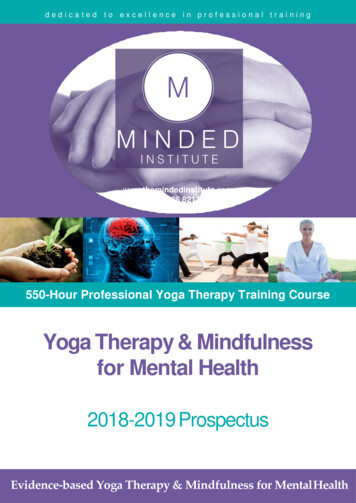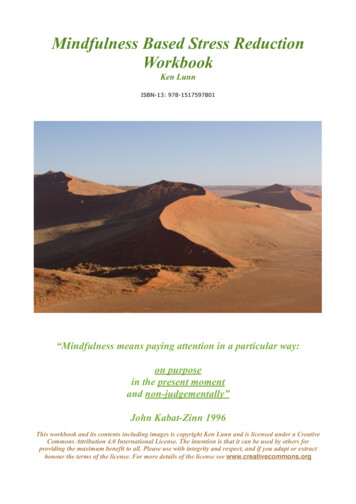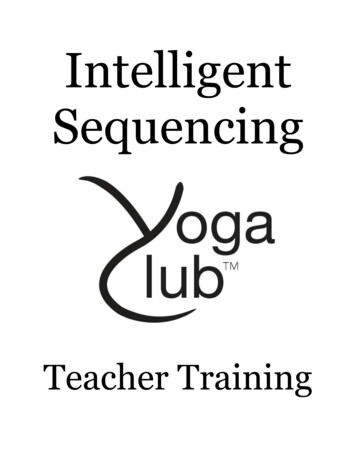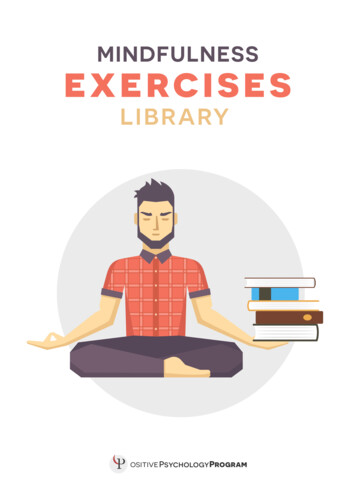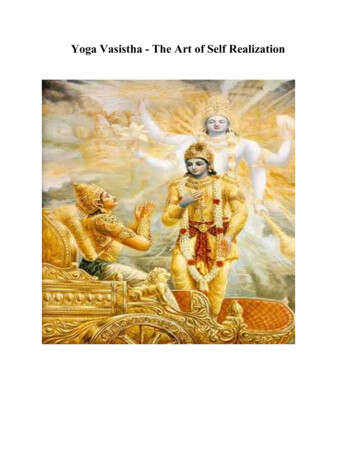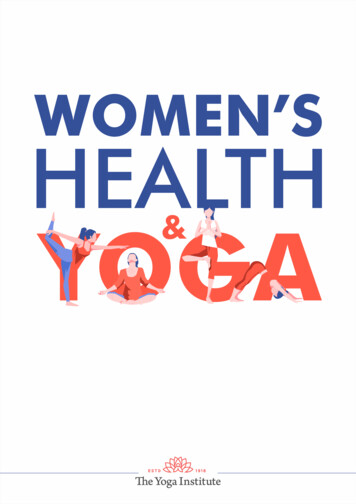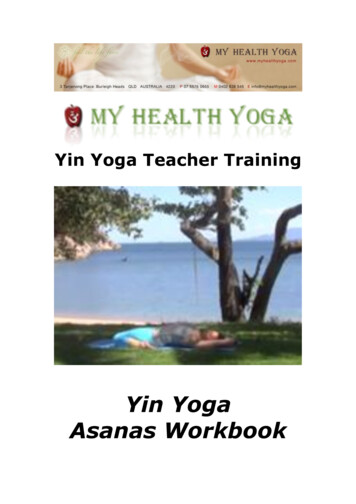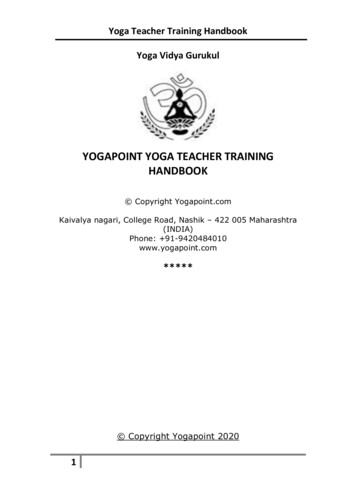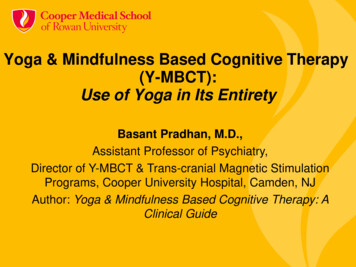
Transcription
Yoga & Mindfulness Based Cognitive Therapy(Y-MBCT):Use of Yoga in Its EntiretyBasant Pradhan, M.D.,Assistant Professor of Psychiatry,Director of Y-MBCT & Trans-cranial Magnetic StimulationPrograms, Cooper University Hospital, Camden, NJAuthor: Yoga & Mindfulness Based Cognitive Therapy: AClinical Guide
Professional DisclaimerDr. Basant Pradhan was the PI of a collaborative study on PTSDwith the National Institute on Aging (NIA). He has no financialrelationship with any private company that would constitute aconflict of interest on this topic.
Objectives:After this, participants will be able to summarize things below: Concepts of Yoga & meditation are profoundly distorted,underused & when used, mostly used in piece meal, not in its entirety Meditation is part of Yoga Meditation is a state of mind, not an action Meditation has 2 components: Concentration & Mindfulness Yoga in its entirety is three fold: Life Style, Mind-Body Tools &Meditation Use of ALL THREE parts together based on authenticscriptural philosophy, techniques & practice are necessaryfor correct use of Yoga & to improve the usefulness Human Experience is Five Folds: The Five Factor Model Yoga & Mindfulness Based Cognitive Therapy (Y-MBCT)through its six evidence based models attempts to bridge theseconsiderable gaps
PROLOGUE:Distortion at its extremesHatha Yoga Vs. Hot Yoga
Yoga as proposed originally: Ancient India YOGA in its entirety: Contemplative strategies to gain insight:About nature of thoughts & experiences (so that wisdom will govern our actions) To understand things AS THEY ARE (REALITY, Pali. tathata) To re-access a natural, ve state of mind (cf. Baby) to experience wisdom (vs. illusion/maya) & sustained day-to-daypeace of mind (vs. dvanda/unrest), regardless of circumstances Philosophy of Yoga is based on the facts below: All human experience created from WITHIN. Stress: By Cognitive Dissonance (Maya) Amelioration of stress & change of experience are possible: Bychanging internal representations in mind & brain (insight wisdom)
ORIGINALTHINKERS:Buddha,Patanjali &Vivekananda(Ancient India &Modern India)
Yoga in its entirety is three fold: All 3 Necessary
Meditation is 6th & 7th limbs of Eight Limbed YogaMeditation is NOT an action: It is a state of mind
Yoga in its entirety is three-fold:Life style, Tools, Meditation
Meditation is two-fold:(OM)Concentration(FA) & Mindfulness
Mind & Meditation: As Conceptualized in Scriptures Locus of all experience: INSIDE MIND: Always running away from this locus (Projection) Mechanism of action of Mindfulness: Reversal of Projection.To Turn mind inwards (the locus of all experiences) Technique: Con-centration (centering of consciousness) Mindfulness (Sati Patthana) The Middle Way (The whole life is a meditation) Basic Tools: You (nobody else) & Your Body & Breathing Transformation of Breathing to a meditative experience in 7 steps Generalization to Daily Life is Necessary (Practice Log)Ongoing standardization by Pradhan (1993 onwards)
The FiveAggregates inco-creation of allHumanExperience:everything is justelaboration ofthese fivephenomena.Panicexperience canbe seen as aprototype of thismodel(Adapted fromPradhan’s Book,2014, withpermission)
Mind & Meditator :The Lake Model (Pradhan, 2014)Mind &Meditatorare Differentfrom EachOther:DetachedObservationof Mind isNecessary.That isMeditation
Three modes of operation of Mind: DOING Mode: Default mode (On call mode) BEING mode: (Vacation mode; Being One with experience) DRIVEN-DOING : Deadline mode (No experience) GOOD FUNCTIONING: More ‘Being’ mode, less‘Doing’ mode, much less ‘Driven-doing’ modeHOW: By upgrading the technology to master the mind
The Three Unmindful Styles in Our Life: Source of All Stresso Extreme/Non-Middle Way views & life styleso Clinging to Self (I-dentify)o Not staying with the present experience (Time travelling)MEDITATION is a mental state cultivated bypracticing the combination of opposites to above three: MIDDLE WAY view (an awareness rather than doing the actions), DETACHED OBSERVATION & Staying FOCUSED in the PRESENT MOMENTGoal: To experience things as they are (Pali. tathata)All done by using the breath (& body) as the anchor forMeditation (Stations of Mindfulness, Nyanaponika, 1954)
The Chief Theory of Mind & Experiencein the Abhidhamma :The Five Factor Model of Human Experience Human Experience is a Co-creation by the Aggregates One’s Field of Awareness is the Platform to Experience/Experiment to effect the Change All Experiences are Temporary & Prone to Change
FIVE FACTORS MODEL OF MIND: Experience as co-creation of theseaggregates (Buddha, 6th century BC; Pradhan, ughtsFeelingsWill, Urge,ImpulsesDrug RYAmnesia, PTSDflashbacks,CHANGE OF EXPERIENCE IS POSSIBLE
Pradhan’s Ongoing Work (Demystification & Standardization of Yoga)Standardized Yoga meditation Program for Stress Reduction (SYMProSR ): (wellness model, 1993 onwards): piloted on 150 personsY-MBCT (illness models, 1998 onwards): Five Dx specific models(depression; OCD, PTSD & other anxiety disorders; dyslexia & ADHD;addiction, anger & impulse control disorders; somatic & conversion Sx) Online Video:http://www.youtube.com/watch?v pvHDCZ5D7Xk Assessment Scale for Mindfulness Interventions (ASMI , Pradhan, 2012) Arousal Response during Trauma Memory Reactivation (ART-MR Pradhan & Gray, 2013-14): PTSD specific scale Yoga & Mindfulness Based Cognitive Therapy (Y-MBCT: Book: 2014)
SYMPro-SR & Y-MBCT protocolsare based on: The 4 Original schools of Yoga(Veda, Vedanta, Buddhism &Tantra), Standardized Middle Way LifeStyle, Neuro-biologically informedmeditation (bottom up model ofmeditation) & Standardization of CBT.Piloted in 300 subjects (India & US)
SYMPro-SR & Y-MBCT in a Nutshell Philosophies of Mind & Life: Middle Way & Five Factors Model Based on meditation as science of attention & empathy Cognitive & Behavioral tools for standardization & adherence Standardized sitting posture & Yogic procedures (Kriya) Conscious Sensory Withdrawal (Sans. Pratyahara: 5th step) Attaining the meditative states with standardized use of the2 meditative styles: Concentrative (FA) & Open Monitoring (OM) Concentrative meditation: TRATAK (fixed gazing) Open Monitoring: MINDFULNESS (with five factor model)
SYMPro-SR & Y-MBCT Models
Practical Tips for Yoga-Meditation: SYMPro-SR/Y-MBCT: Standardized Practice Log available Routine Practice at Home (Longer version): 15 minutes in AM after waking up 15 minutes at night before going to bed As needed Quick Practice at Work (Shorter version): As needed practice: 5 minutes in different situations in daily life Use of CBT & experiential tools for ensuring effective practice of : Middle Way philosophy in daily life, The Five Factor Model of experience & Mindfulness meditation
SUMMARY: SYMPro-SR & Y-MBCT Scriptural but scientific: Evidence based & feasible Psychologically, neuro-biologically & spiritually informed Feasible for monks as well as modern people: MeditativeLife Style (Middle Way) standardized as well Compatible with Illnesses & wellness Other therapies (Psychotherapies, Medications, TMS) Huge potential for further collaborations & applications inmulti-center trials examining utility of Yoga & mindfulness
REFERENCES: Bhante Gunaratana (2009). Beyond Mindfulness In Plain English. Buddhaghosha (circa. 430 CE): Visuddhimagga (The Path of Purification;Nyanamoli [Eng. 1976], Berkley, CA: Sambhala. Dalai Lama (2009). The Middle Way: Faith Grounded in Reason. Wisdom Pub. Daniel Goleman (1988). The Meditative Mind: Varieties of meditative experience. Jon Kabat-Zinn (1990): Full Catastrophe Living. New York: Delacorte Press. Newberg, A.B. (2010). Principles of Neurotheology; Ashgate Publishing. Nyanaponika Thera (1965). The Heart of Buddhist Meditation; Samuel Weiser. Pradhan, B.K. (2014): Yoga & Mindfulness Based Cognitive Therapy (YMBCT): A Clinical Guide (Springer). Pradhan et al (2013-14, unpublished): Ketamine & mindfulness in refractoryPTSD. Pilot study with investigators from Cooper University Hospital & NIA. Satchidananda, S. (1978). The Yoga Sutras of Patanjali: Translations andcommentary; Yogaville, Virginia: Integral Yoga Publications. Segal, Z. v., Williams, J. M. G., & Teasdale, J. D. (2002, 2013). MBCT fordepression: A New Approach to Preventing Relapse Vivekananda (1956). Raja Yoga. New York: Ramakrishna Vivekananda Center. ARTICLES: Very many to be cited.
Thank you !
Yoga & Mindfulness Based Cognitive Therapy (Y-MBCT): Use of Yoga in Its Entirety Basant Pradhan, M.D., Assistant Professor of Psychiatry, Director of Y-MBCT & Trans-cranial Magnetic Stimulation Programs, Cooper University Hospital, Camden, NJ Author: Yoga & Mindf
